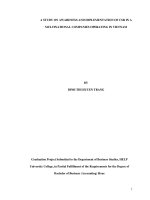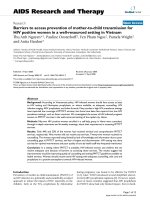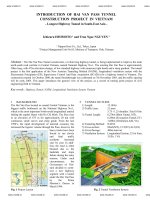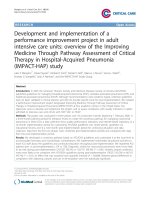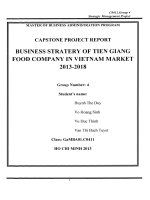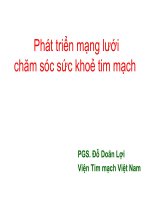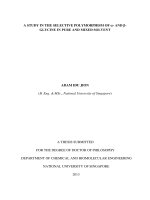Modelling of a vacuum consolidation project in Vietnam
Bạn đang xem bản rút gọn của tài liệu. Xem và tải ngay bản đầy đủ của tài liệu tại đây (923.15 KB, 18 trang )
Nguyen Trong Nghia. Journal of Science Ho Chi Minh City Open University, 9(2), 67-84
67
MODELLING OF A VACUUM CONSOLIDATION PROJECT
IN VIETNAM
NGUYEN TRONG NGHIA1,*
1
Ho Chi Minh City Open University, Vietnam
*Corresponding author, email:
(Received: August 23, 2018; Revised: October 17, 2018; Accepted: May 21, 2019)
ABSTRACT
Ground improvement technique by prefabricated vertical drain (PVD) in combination with
vacuum preloading is widely used to facilitate consolidation process and reduce residual
settlement. However, this technique seem hardly be estimated by both analytical method and
numerical method because it has complex boundary conditions (such as vacuum pressure changing
with time). Moreover, lateral displacements caused by this technique are also significant problem.
Numerical modelling may be an effective design tool to estimate behavior of soft soil treated by
this method, however it needs to have a proper calibration of input parameters. This paper
introduces a matching scheme for selection of soil/drain properties in analytical solution and
numerical modelling (axisymmetric and plane strain conditions) of a ground improvement project
by using Prefabricated Vertical Drains (PVD) in combination with vacuum and surcharge
preloading. In-situ monitoring data from a case history of a road construction project in Vietnam
was adopted in the back-analysis. Analytical solution and axisymmetric analysis can approximate
well the field data meanwhile the horizontal permeability need to be adjusted in plane strain
scenario to achieve good agreement. In addition, the influence zone of the ground treatment was
examined. The residual settlement was investigated to justify the long-term settlement in
compliance with the design code. Moreover, the degree of consolidation of non-PVD sub-layers
was also studied by means of two different approaches.
Keywords: Ground improvement; Prefacricated vertical drain; Soft clay; Stability; Vacuum
consolidation.
1. Introduction
1.1. Site
Due to the rapid development of industrial
zones in Vietnam, the infrastructures such as
roads need to be built faster. Therefore, it
requires a faster soft soil treatment method
rather than traditional methods such as
vertical sand drain or vertical prefabricated
drain (PVD) with surcharge preloading
method. Vacuum consolidation for vertical
prefabricated drains in combination with
surcharge preloading was proved to be the
effective method because of the lower
embankment surcharge height and shorter
construction time than the conventional PVD
preloading method (Bergado el al., 1998;
Chu et al., 2000; Yan and Chu, 2005; Kelly
and Wong, 2009; Rujikiatkamjornand and
Indraratna, 2007, 2009, 2013; Indraratna et al.,
2005, 2011, 2012; Artidteang et al., 2011;
Geng et al., 2012; Chai et al., 2013a, 2013b;
Vootipruex et al.,2014; Lam et al., 2015).
Bachiem road project (2017-2018) treated
by the PVD vacuum consolidation technique
68
Nguyen Trong Nghia. Journal of Science Ho Chi Minh City Open University, 9(2), 67-84
locates at the south of Vietnam. It is 20
kilometers from the Ho Chi Minh City as
shown in Fig.1. This area is in the Saigon Dong Nai river delta (SDRD). The average
thickness of the soft clay in this area is more
than 20 meters. This soft clay, with low shear
strength and high compressibility, may induce
large settlement and stability problem for
construction (Long et al., 2013).
Figure 2. Project’s overall layout
Figure1. The project location
The Bachiem road project was 2.2 km long
from Bachiem bridge to Hiep Phuoc Industrial
zone. Fig. 2 shows the overall layout of this
project. The right hand side of this project
is the Sai Gon river and there are still a
number of rice fields and agricultural lands
surrounding the project indicating that subs
soil is very soft.
Fig.3 shows a typical section in this
project in which numerous monitoring
instrumentations were installed to examine soft
ground treatment quality and possible damages
to nearby houses. A selected section for
numerical model is the section with the PVD’s
length of 15.5m as highlighted in Fig. 3. The
PVD’s length of this section was limited due to
restriction of mandrel height under high
electrical voltage lines. This section may cause
differential settlements and damages to the
future road. Thus, extensive monitoring
measurements and ground investigations were
carried out. Fig. 4 illustrates the analytical
section after the construction.
Figure 3. Layout of analytical section
Nguyen Trong Nghia. Journal of Science Ho Chi Minh City Open University, 9(2), 67-84
69
Figure 4. The analytical section after construction
1.2. Soil profile
The soil profile of analysis section consists
of 4 sub-soil layers:
Top crush (0 m to 1 m): the surface soil
includes: a thin layer with organic clay, bluegrey, yellow-grey, yellow-brown. This layer is
mainly used for: for filling the banks,
embankments, floor tiling, and rice fields.
Layer 1a (1 m to 23 m): A very soft clay
with some organic matter and thin sand layers
with an average water content of 84.5%, plastic
limit (PL) of 37.5%, liquid limit (LL) of
91.3%, unit weight of 14.8 kN/m3 and SPTN values from 0 to 1.
Layer 1b (23 m to 26 m): A soft clay
with some organic matters and thin sand layer
with an average water content of 78.1%, PL of
36.6%, LL of 89.1%, unit weight of 1.50
kN/m3 , and SPT-N values from 2 to 6.
Layer 2 (26 m to 29 m) silty or silty
sand which is loose to medium dense with
SPT-N values from 8-25.
Layer 1a is very soft to soft clay. Without
ground treatment, the road construction would
be affected due to the post-settlement.
Mechanical properties of layer 1a are: CR
(compression ratio) = 0.35, RR (recompression
ratio) = 0.042, OCR (over consolidation ratio)
= 1 to 2 which decreases with depth and cv
(coefficient of vertical consolidation) = 2
m2 /year (for NC stage) as illustrated in Fig.5.
Figure 5. Soil mechanical parameters of layer 1a
70
Nguyen Trong Nghia. Journal of Science Ho Chi Minh City Open University, 9(2), 67-84
Permeability value of layer 1a is a crucial
factor for numerical analyses. In fact, the
permeabilities change with pressure and void
ratio as shown in Fig. 6 and Fig. 7. These
figures were derived from odometer tests at
different depths from the analytical section.
The input permeability value for numerical
modeling was simplified as a constant value.
Therefore, the lab permeability of kv 1105
(m/day) is used as vertical permeability.
For most natural deposits, the horizontal
permeability k h is greater than that in vertical
direction, and the ratio ( kh kv ) varies from 1 to
15 (Jamiolkowski et al. 1983). The horizontal
permeability, therefore, was assumed as
kh 2kv 2 105 (m/day). Initial void ratio
was simplified as a constant input value with
eo 2 for layer 1a as shown in Fig.7.
Figure 6. Permeability with pressure changes
Figure 7. Permeability with void ratio changes
1.3. PVD properties
PVDs were installed in a triangle pattern
with spacing of S 1 (m). Thus, the equivalent
influential diameter is De 1.05S 1.05 (m)
(Baron. 1974). The PVDs can be simplified
into circular shape with equivalent drain’s
dimension of d w 2(a b) 0.066 (m) (Rixner
et al 1986). The mandrel dimension was
0.06m×0.12m (w×l). Thus, the equivalent
mandrel dimension in circular shape were
dm 2
wl
0.096
(m). Moreover, the diameter
of smear zone is d s
5 6
2
d m 0.24 0.29 (m)
Nguyen Trong Nghia. Journal of Science Ho Chi Minh City Open University, 9(2), 67-84
(Rixner et al 1986). The value of d s 0.25 (m)
was adopted in this study. Plus, well resistant
with very high permeability of the drain
k w 100 (m/day) was not considered in this
model.
2. Methodology
Matching scheme is proposed in order to
derive proper properties of soil/drain used in
design stage. It can be done by following 3 steps:
1- Generating consolidation problem of
PVD by the analytical solution (Jie Han, 2015)
with initial soil/drain properties. It is noted that
the analytical solution by Hansbo (1981)
modified by Jie Han (2015) is used for PVD
design of surcharge preloading technique. It
may also be appropriately applied for timedependent loading and vacuum consolidation
technique.
2- Simulating this consolidation problem
in a single unit cell under axisymmetric
condition with similar initial soil/drain
properties. Permeability ratio of undisturbed
clay to smear clay ( kh / ks ) is calibrated by the
settlement of numerical model, the analytical
solution, and the actual site data. The
appropriate soil/drain properties will be
adopted in subsequent 2D numerical model.
3- Modeling complete consolidation case
under plane strain (2D) condition. It is to verify
both vertical and horizontal displacements with
field data.
3. Results and discussion
3.1. Generating analytical solution
A simplified method by Jie Han (2015) was
71
employed to account for the loading steps. This
method converted the earlier degree of
consolidation at the time ti and pressure pi to
the degree of consolidation U j under new
pressure p j with an equivalent time t j ti t
in which t is an additional time calculated
using the total time. Further, vacuum pressures
are approximately considered as a loading
which can be added with the surcharge loading.
Initial soil properties taken from Fig. 5 are
summarized in Table 1. In addition, the
horizontal consolidation coefficient (ch) was
assumed to be double the vertical value. In other
words, the ch value of 4 m2/year is adopted. It is
noted that the layer top-crush and silty sand
layer (layer 2) were neglected in this analytical
solution due to their low deformation.
Moreover, the actual loading sequence
of the analytical section presented in Fig. 8
was carried out with two-step loadings. It
was simplified as a single-ramp loading. In
addition, vacuum pumps gained the maximum
vacuum pressure of -60 kPa for only 5 days.
Fig. 9 demonstrates a comparison of
surface settlements by the analytical solution
and the field data with the permeability ratio
of kh / ks 3 . The analytical results are in good
agreement with the field measurements.
Therefore, the initial soil properties and the
permeability ratio of kh / ks 3 are then
applied for axisymmetric numerical modeling
of the subsequent step.
Table 1
Initial soil properties for the analytical model
Layer
Depth (m)
RC
RR
pc (kPa)
1a +PVD
1a+PVD
1a+PVD
1a+PVD
1a
1a
1b
1-3
3-7
7-11
11-15
15-19
19-23
23-26
0.35
0.35
0.35
0.35
0.35
0.35
0.23
0.042
0.042
0.042
0.042
0.042
0.042
0.023
31.6
49
72.7
95.4
118.6
141.8
156.3
72
Nguyen Trong Nghia. Journal of Science Ho Chi Minh City Open University, 9(2), 67-84
Figure 8. Loading sequence
Figure 9. Comparison of surface settlement between the analytical solution and field data
3.2. Numerical modelling for axisymmetric
condition
ABAQUS numerical software is utilized
for modelling the consolidation problem of
axisymmetric numerical modeling. The model
is shown in Fig. 10 with a unit cell section. Total
height of the model is 29m with 4 soil layers.
The length of PVD is 15m. The top crush and
layer 2 were also modelled in this model with
the thickness 1m and 3m, respectively. The
vacuum pressure and the surcharge load were
applied at the top boundary. Vacuum pressure
was assigned as the negative pore water
pressure at a node which could later increase the
effective stress and induce the settlement.
ABAQUS software is capable of modelling
vacuum pressure in cooperating with the
advanced soil models such as modified
Camclay model and Morh-coulomb model. The
soft soil model based on the modified Camclay
model is widely applied for PVD consolidation
problems of soft soil (Rujikiatkamjornand and
Indraratna. 2008., Lin and Chang. 2009). The
soft soil properties for the modified Camclay
model are listed in Table 2. In specific, the insitu past pressure ( pc ) in layer 1a has been
approximated by 6 separated layers. It is
Nguyen Trong Nghia. Journal of Science Ho Chi Minh City Open University, 9(2), 67-84
because the actual past pressures (in Fig. 5) are
about 10kPa - 20 kPa larger than the effective
pressures, whereas, the past pressure can be
only defined as constant value along the depth
of a layer in the model. Moreover, layer 2 is silty
73
sand layer which was simplified in the modified
Camclay model with compressive indices of
0.011 and 0.11 and high permeability
of kh 1 (m/day).
Figure 10. Axisymmetric numerical model
Table 2
soil properties for Modified Camclay model
Layer
Depth (m)
pc (kPa)
M
k h (m/day)
1a+PVD
1-3
0.054
0.459
31.6
0.8
2 105
1a+PVD
3-7
0.054
0.459
49
0.8
2 105
1a+PVD
7-11
0.054
0.459
72.7
0.8
2 105
1a+PVD
11-15
0.054
0.459
95.4
0.8
2 105
1a
15-19
0.054
0.459
118.6
0.8
2 105
1a
19-23
0.054
0.459
141.8
0.8
2 105
1b
23-26
0.03
0.303
156.3
1
1105
2
26-29
0.011
0.11
168.3
1
1
74
Nguyen Trong Nghia. Journal of Science Ho Chi Minh City Open University, 9(2), 67-84
Settlement (m)
Numerical settlement results of the
axisymmetric model given in Fig .11 show
excellent agreements in not only surface
settlement but also in all deep settlements. It
0
0.2
0.4
0.6
0.8
1
1.2
1.4
1.6
1.8
2
implies that the numerical and analytical
solution could have the consistent results
if soil/drain properties were appropriately
calibrated.
15m depth
10.5m depth
2.5m depth
Asymmetrical
numerical modelling
Field data
0
20
40
60
80
Surface settlement
100 120 140
Time (days)
160
180
200
220
Figure 11. Comparison of settlements by the Asymmetrical numerical modeling and field data
3.3. Plane strain (2D) numerical modeling
The soil/drain properties above are utilized
for 2D numerical analysis. Meshing is given in
Fig.12 with 647 8-node elements of CPE8RP
and CPE8R. Soft soil layer 1a with PVD was
simplified as a single layer with equivalent
vertical permeability (Chai et al., 2001).
The equivalent vertical permeability kev is
an essential factor by Chai’s approach is
presented in simple equations which
considering the PVD’s influenced factor and
undisturbed vertical, horizontal permeability
( kv , kh ):
2.5l 2 kh
kev 1
(1)
kv
2
De kv
l is the drainage length of PVD
where:
improved zone, the influence factor of PVD
geometry as expressed by Hansbo (1981).
3 2l 2 kh
n kh
ln ln( s)
(2)
4
3qw
s ks
where: qw is the discharge capacity. This
value has been extensively studied as a very
large value about qw 100m3 / year , while the
horizontal permeability is very small value.
Therefore the last term in equation (2) can be
D
d
neglected. n e , and s s .
dw
dw
Nevertheless, the ratio of permeability of
k
Rs h 3 used to derive the equivalent
ks
vertical permeability leads to faster predicted
settlement than field data measurements.
Therefore, it is proposed a higher of ratio of
permeability of Rs kh 8 with corresponding
ks
kev 1.62 103 (m/day). As a result, the
settlement results of the 2D numerical analysis
are matched with the field data as shown in
Fig.13. The ratio of permeability of
k
Rs h 8 was also proposed by Lam et al.
ks
(2015) when modeling vacuum consolidation
of PVD in second international Bangkok
airport.
Nguyen Trong Nghia. Journal of Science Ho Chi Minh City Open University, 9(2), 67-84
75
Figure 12. 2D plane strain numerical model
Figure 13. Comparison of settlements by the 2D numerical modeling and field data
3.4. Influence zone
Influence zone can be determined by
means of soil deformation during the
treatment. As shown in Fig. 14, the maximum
lateral displacement is 0.5 m inward the
embankment due to vacuum force. This
movement significantly decreased to 0.1m
at 7.5m away from the slope toe; and it
was negligible at 10m away from the
embankment’s toe. Thus, it can be concluded
that in this soil treatment the safe boundary
may extend to the length of at least 10m from
the embankment’s toe. Moreover, an existing
structure may be severely damaged if it locates
within 7.5m from the surcharge toe.
76
Nguyen Trong Nghia. Journal of Science Ho Chi Minh City Open University, 9(2), 67-84
Figure 14. Lateral displacement by 2D numerical modelling
3.5. Evaluating degree of consolidation
of non-PVD zone
The most challenging task is the
evaluation of the untreated zone because it can
have a very low dissipation of the excess pore
pressures and it may cause large settlement. By
means of numerical modeling, this paper
presents two simple approaches including:
(1)evaluation through the excess pore water
pressures dissipation and (2) evaluation
through the effective vertical pressure changes.
A-The first approach
Pore pressure in the axisymmetric model
given in Fig.15 shows that excess pore
pressure of 26 kPa still remains in the untreated
zone while the treated zone is completely
consolidated with the excess pore pressure of 60 kPa (equal to the vacuum pressure). The
total magnitude of excess pore water
pressure of 100kPa is the summation of the
maximum surcharge load (40 kPa) and the
maximum vacuum pressure (-60 kPa).
Therefore, the degree of consolidation at the
final consolidation stage (240 days) is
calculated by the following equation:
usurch arg e ut 40 26
U Asym
100% 14% (3)
utotal
100
where:
U Asym
is
the
degree
of
consolidation by the axisymmetric model,
usurch arg e is the maximum excess pore pressure
induced by maximum surcharge loading, utotal
is the total of excess pore pressure, ut is the
excess pore pressure at the final consolidation
stage (240 days).
The excess pore pressure at the final
consolidation stage in the 2D model is shown
Fig.16. The excess pore pressure of untreated
zone only 6.849 kPa which is lower than that
of axisymmetric model. The reason may
come from the difference in the surcharge
stress distribution in 2D model and in
the axisymmetric model. Fig.17 presents
the vertical stress distribution due to an
embankment by analytical solution. It can be
seen from Fig.17 that the vertical stress
Nguyen Trong Nghia. Journal of Science Ho Chi Minh City Open University, 9(2), 67-84
reduces when the depth increases under an
embankment. The middle of the untreated zone
has a depth of 22m. The influence value at this
depth is I 0.25 .
The maximum stress distribution at that
depth is
z 2I 2 0.25 40 20 (kPa) (4)
The maximum stress at the middle of
untreated zone is also the maximum excess
pore pressure by surcharge loading.
(5)
usurch arg e z 20 (kPa)
The total of excess pore pressure is
summation of the vacuum pressure and the
77
excess pore pressure by the surcharge loading.
utotal uva usurch arg e 60 20 80 (kPa) (6)
The degree of consolidation at the final
consolidation stage is determined by equation:
usurch arg e ut 20 6.8
U2D
100% 16.5% (7)
utotal
80
where U 2D is the degree of consolidation
by the 2D model.
The degree of consolidations by both
numerical models are in good agreement. The
untreated zone had a little increase in the
degree of consolidation (14%-16.5%).
Figure 15. Excess pore pressure at the final consolidation stage by axisymmetric modelling
78
Nguyen Trong Nghia. Journal of Science Ho Chi Minh City Open University, 9(2), 67-84
Figure16. Excess pore pressure at the final consolidation stage by 2D modelling
Figure 17. Stress distribution under an embankment load
B-The second approach
The effective vertical pressure at the initial
stress state is illustrated in Fig.18. The vertical
stress linearly increases along the depth due to
the self weight of soil to the maximum value of
-168.2 (kPa). While, Fig. 19 shows the stress
increase at the final consolidation stage. The
untreated zone shows not much increase in
Nguyen Trong Nghia. Journal of Science Ho Chi Minh City Open University, 9(2), 67-84
term of the effective vertical pressure while the
treated zone shows significant improvement
(the tresses change at least of 70 kPa).
The stress level in the middle of the
untreated zone are about -112 to -126 (kPa) at
the initial state, while they are about -125 to
140 (kPa) at the final consolidation stage (240
days) (Fig.18 and Fig.19). The average vertical
effective stress increase is 't 13.5 (kPa),
while the total vertical effective stress increase
(when the excess pore pressure are completely
79
dissipated at the middle of the untreated zone)
are 'total utotal 80 (kPa). Therefore, the
degree of consolidation is determined by
equation:
't 13.5
(8)
U
100% 16.8%
'total
80
The degrees of consolidation by the first
and second approaches are almost matched
(16.5 and 16.8 %, respectively) indicating that
the untreated zone has very low improvement
with the average stress increase of 13.5 kPa.
Figure 18. the initial state of vertical effective stress
Figure 19. the vertical effective stress at final consolidation stage
80
Nguyen Trong Nghia. Journal of Science Ho Chi Minh City Open University, 9(2), 67-84
3.6. Field verification
Field tests by static cone penetrated test
(CPTu) carried out before and after treatment
were shown in Fig.20. The treated zone shows
greatly improvement in term of the net cone
resistance (0.65 MPa). with almost double the
initial value (0.35 MPa) while, the untreated
zone has a little of increase in cone resistance.
That can be explained from the shear strength
increase by SHANSEP technique (Ladd 1977).
cu
cu
m
(9)
OCR
v OC v NC
where cu
v NC
0.25 for silty clay, m 0.8 ,
OCR 1.2 is the over consolidation ratio of
the middle of untreated zone.
Substituting the above values to equation
(9) yields
cu
0.8
(10)
0.25 1.2 0.29
v
Substituting the vertical effective stress
increase 'v the equation (10) can be rewritten
in the form of shear strength increase cu .
cu
v
0.29
(11)
Based on the plane strain analysis, the
average vertical effective stress increase by
the numerical method of 'v 13.5 (kPa),
subsequently the increase in shear strength is:
cu 0.29 13.5 3.9 (kPa).
(12)
The shear strength increase was very low
( cu 3.9 kPa) therefore, it can not make
changes in the net cone resistance of CPT tests.
The results of field tests and numerical
modellings proved the untreated zone could
hardly to be improved by consolidation
technique.
Figure 20. CPTu tests before and after treatment
Nguyen Trong Nghia. Journal of Science Ho Chi Minh City Open University, 9(2), 67-84
3.7. Evaluation of residual settlement
Residual settlement is the serviceability
settlement when the road is under vehicle
loading. The low degree of consolidation of
the non-PVD layer may cause residual
settlements if increased stresses by operational
loading is larger than the past pressures by
surcharge loading. The residual settlements
81
are evaluated by numerical modeling with
whole process of load removal and operation
load. The load removal is the vacuum pressure
of -60 kPa and the operation load is the vehicle
load of 15 kPa. The total time of residual
settlement is 10 years after completing
construction. The loading sequences are given
in Fig. 21.
Figure 21. Loading sequences of load removal and operation load
The estimated residual settlement is
shown Fig. 22 in which no further settlement is
observed. It can be attributed to: (a) operation
surcharge (15kPa) is significantly smaller than
the vacuum load (-60kPa) and (b) stress
increase of 7.5 kPa due to the operation load is
lower than the past stress increase of 13.5 kPa
during the ground treatment. Thus, the residual
settlement is only secondary settlement.
Moreover, the settlement due to the creep
effect can be estimated analytically by
tp
S s C .H .log
(13)
to
where the secondary coefficient
C 1.1102
is determined through odometer tests, H 24
(m) is the total thickness of compresive layer,
t p 15 (years) is the design time, to 1 (year)
is the completed consolidation time. Therefore,
the residual settlement can be calculated as
Ss C .H .log
tp
to
1.1102 24 log
15
0.3 (m) (14)
1
These residual settlement for 15 years is
satisfactory required residual settlement of
0.4m for 15 years according to Vietnam’s road
standard.
82
Nguyen Trong Nghia. Journal of Science Ho Chi Minh City Open University, 9(2), 67-84
Figure 22. Residual settlement
4. Conclusions and recommendations
Several conclusions can be drawn from the
Bachiem road project:
1- This paper introduces a matching
scheme for selecting the soil/drain properties
for numerical modeling. There are excellent
consistent in soil/drain properties of the
analytical solution and the axisymmetric
modeling, while the 2D modeling has to
adjust the equivalent vertical drain with direct
k
relation to the permeability ratio of Rs h
ks
2- The analytical solution and the
axisymmetric modeling have the permeability
ratio of Rs kh 3 , while the 2D modeling has
ks
the permeability ratio of Rs kh 8 . The
ks
analysis results in term of settlement of these
models are in good agreement with the field
data.
3- The lateral displacement of vacuum
consolidation technique investigated by 2D
modeling indicated that the safe boundary for
existing constructions would be 10m from the
embankment’s toe. The effectiveness of soil
treatment can be verified by the CPTu test. The
cone resistance increased significantly within
the PVD boundary, meanwhile,
4- Numerical results of untreated zone are
then verified by the cone penetrated tests. The
field test results are consistent with numerical
results which prove the effectiveness of
the numerical methods in solving the
complicated consolidation problems by PVD
vacuum technique.
Load removal of vacuum pressure and
the operation load of vehicle loading can
be modeled by numerical simulation to
investigate the residual settlement. However, it
need more advance model which is capable of
simulation of creep effect. The residual
settlement of analysis section is satisfied the
required settlement by relevant Vietnam’s
standard
References
Artidteang, S., Bergado, D.T., Saowapakpiboon, J., Teerachaikulpanich, N., Kumar, A., (2011).
Enhancement of efficiency of prefabricated vertical drains using surcharge, vacuum and heat
preloading. Geosynth. Int. 18(1), 35-47.
Asaoka, A. (1978). Observational procedure of settlement prediction. Soils Found. 18(4), 87-101.
Nguyen Trong Nghia. Journal of Science Ho Chi Minh City Open University, 9(2), 67-84
83
Bergado, D.T., Long, P.V., Balasubramaniam, A.S., (1996). Compressibility and flow parameters
from PVD improved soft Bangkok clay. Geotech. Eng. J. 27(1), 1-20.
Balasubramaniam, A.S., Bergado, D.T., Phienwej, N., (1995). The Full Scale Field Test of
Prefabricated Vertical Drains for the Second Bangkok International Airport (SBIA) (final
report). Division of Geotechnical and Transportation Engineering, AIT, Bangkok, Thailand,
p. 259.
Bergado, D.T., Chai, J.C., Miura, N., Balasubramaniam, A.S., (1998). PVD improvement of soft
Bangkok clay with combined vacuum and reduced sandembankment preloading. Geotech.
Eng. J. Southeast Asian Geotech. Soc. 29(1), 95-121.
Bergado, D.T., Balasubramaniam, A.S., Fannin, R.J., Holtz, R.D., (2002). Prefabricated vertical
drains (PVDs) in soft Bangkok clay: a case study of the new Bangkok International Airport
Project. Can. Geotech. J. 39, 304-315.
Chai, J.-C., Shen, S.-L., Miura, N., and Bergado, D.T. (2001). “Simplified method of modeling
PVD-improved subsoil.” Geotechnique, 127(11), 965-972.
Chai, J.C., Miura, N., Bergado, D.T., (2008). Preloading clayey deposit by vacuum pressure with
cap-drain: analyses versus performance. Geotext. Geomembr, 26, 220-230.
Chai, J.C., Ong, C.Y., Carter, J.P., Bergado, D.T., (2013a). Lateral displacement under combined
vacuum pressure and embankment loading. Geotechnique, 63(10), 842-856.
Chai, J.C., Carter, J.P., Bergado, D.T., (2013b). Behaviour of clay subjecting to vacuum and
surcharge loading in an odometer. Geotech. Eng. J. SEAGS AGSSEA, 44(4), 1-8.
Chu, J., Yan, S.W., Yang, H., (2000). Soil improvement by the vacuum preloading method for an
oil storage station. Geotechnique, 50(6), 625-632.
Geng, X.Y., Indraratna, B., Rujikiatkamjorn, C., (2012). Analytical solutions for a single vertical
drain with vacuum and time-dependent surcharge preloading in membrane and
membraneless system. Intl. J. Geomech. ASCE, 12(1), 27-42.
Hausmann, M.R. (1990). Engineering Principal of Ground Modification. McGraw-Hill Publishing
Company, p. 631.
Indraratna, B., Rujikiatkamjorn, C., Sathananthan, I., (2005). Analytical and numerical solutions
for a single vertical drain including the effects of vacuum preloading. Can. Geotech. J., 42,
994e1014.
Indraratna, B., Rujikiatkamjorn, C., Ameratunga, J., Boyle, P., (2011). Performance and prediction
of vacuum combined with surcharge consolidation at Port of Brisbane. J. Geotech.
Geoenviron. Eng. ASCE, 137(1), 1009-1018.
Indraratna, B., Rujikiatkamjorn, C., Balasubramaniam, A.S., McIntosh, G., (2012). Soft ground
improvement via vertical drains and vacuum assisted preloading. Geotext. Geomembr,
30(1), 16-23.
Han, J. (2015) Priciples and practice of ground improvement. Wily Publishing Company, p. 222.
Kelly, R.B., Wong, P.K., (2009). An embankment constructed using vacuum consolidation. Aust.
Geomech, 44(2), 55-64.
Mesri, G., Strak, T.D., Ajlouni, M.A., Chen, C.S., (1997). “Secondary Compression of Peat with
84
Nguyen Trong Nghia. Journal of Science Ho Chi Minh City Open University, 9(2), 67-84
or without Surcharging” Intl. J. Geomech. ASCE, 124(5), 411-421.
Lam, L.G., Bergado, D.T., Hino, T., (2015). PVD improvement of soft Bangkok clay with and
without vacuum preloading using analytical and numerical analyses. Geotext. Geomembr,
43, 547-557
Ladd, C.C., DeGroot, D.J., (2003). Recommended practice for soft ground site characterization:
Arthur Casagrande Lecture. In: Proc. 12th Panamerican Conference on Soil Mechanics and
Geotechnical Engineering, MIT, U.S.A.
Lin, D.G and Chang, K.T., (2009). Three-dimensional numerical modeling of soft ground
improved by prefabricated vertical drains. Geosymthetics international, 16(5), 339-353.
Long, P.V. (2005). Existing problems of vietnamese design standards for highway embankment
on soft ground. Proc. Of the 13th conference on Road and Brigde sections, Politechnical
University Ho Chi Minh City, 1, pp733-738
Long, P.V., Bergado, D.T., Giao, P.H., Balasubramaniam, A.S., Quang, N.C., (2006). Back
analyses of compressibility and flow parameters of PVD improved soft ground in Southern
Vietnam. In: Proc. of the 8th International Conference on Geosynthetics, Yokohama 2006,
2, pp. 465-468.
Long, P.V., Bergado, D.T., Nguyen, L.V., Balasubramaniam, A.S., (2013). Design and
performance of soft ground improvement using PVD with and without vacuum
consolidation. Geotech. Eng. J. SEAGS AGSSEA, 44(4), 37-52.
Long, P.V., Bergado, D.T., Nguyen, L.V., Balasubramaniam, A.S., (2013). Design and
performance of soft ground improvement using PVD with and without vacuum
consolidation. Geotech. Eng. J. SEAGS AGSSEA, 44(4), 37-52.
Long, P.V., Nguyen, L.V., Tri, T.D., Balasubramaniam, A.S., (2016). Performance and analyses
of thick soft clay deposit improved by PVD with surcharge preloading and vacuum
consolidation - a case study at CMIT. Geotech. Eng. J. SEAGS AGSSEA, 19(4), 125-134.
Ong, C.Y., Chai, J.C., (2011). Lateral displacement of soft ground under vacuum pressure and
surcharge load. Front. Archit. Civ. Eng. China, 5(2), 239-248.
Rujikiatkamjorn, C., Indraratna, B., (2007). Soft ground improvement by vacuum assisted
preloading. Aust. Geomech. J. (December), 19-30.
Rujikiatkamjorn, C., Indraratna, B., (2008). 2D and 3D Numerical Modelling of Combined
Surcharge and Vacuum preloading with vertical drains. Geomech. J. (April), 144-156.
Rujikiatkamjorn, C., Indraratna, B., (2009). Design procedure for vertical drains considering a
linear variation of lateral permeability within the smear zone. Can. Geotech. J., 46(3),
270-280.
Rujikiatkamjorn, C., Indraratna, B., (2013). Current state of the art in vacuum preloading for
stabilizing soft soil. Geotech. Eng. J., 44(4), 77-87.
Voottipruex, P., Bergado, D.T., Lam, L.G., Hino, T., (2014). Back-analysis of low parameters of
PVD improved soft Bangkok clay with and without vacuum preloading from settlement data
and numerical simulations. Geotext. Geomember, 42(5), 457-467.
Yan, S.W., Chu, J., (2005). Soil improvement for a storage yard using the combined vacuum and
fill preloading method. Can. Geotech. J., 42(4), 1094-1104.

